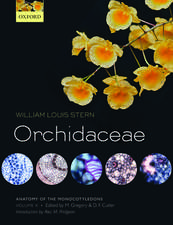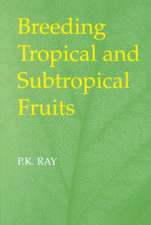Genomics of Plant Genetic Resources: Volume 1. Managing, sequencing and mining genetic resources
Editat de Roberto Tuberosa, Andreas Graner, Emile Frisonen Limba Engleză Hardback – 19 noi 2013
| Toate formatele și edițiile | Preț | Express |
|---|---|---|
| Paperback (2) | 1071.87 lei 38-44 zile | |
| SPRINGER NETHERLANDS – 18 sep 2016 | 1071.87 lei 38-44 zile | |
| SPRINGER NETHERLANDS – 17 sep 2016 | 1228.15 lei 6-8 săpt. | |
| Hardback (2) | 1242.52 lei 6-8 săpt. | |
| SPRINGER NETHERLANDS – 15 ian 2014 | 1242.52 lei 6-8 săpt. | |
| SPRINGER NETHERLANDS – 19 noi 2013 | 1243.78 lei 6-8 săpt. |
Preț: 1243.78 lei
Preț vechi: 1516.80 lei
-18% Nou
Puncte Express: 1866
Preț estimativ în valută:
238.06€ • 245.33$ • 200.98£
238.06€ • 245.33$ • 200.98£
Carte tipărită la comandă
Livrare economică 03-17 martie
Preluare comenzi: 021 569.72.76
Specificații
ISBN-13: 9789400775718
ISBN-10: 9400775717
Pagini: 500
Ilustrații: XXI, 710 p. 101 illus., 82 illus. in color.
Dimensiuni: 155 x 235 x 35 mm
Greutate: 1.19 kg
Ediția:2014
Editura: SPRINGER NETHERLANDS
Colecția Springer
Locul publicării:Dordrecht, Netherlands
ISBN-10: 9400775717
Pagini: 500
Ilustrații: XXI, 710 p. 101 illus., 82 illus. in color.
Dimensiuni: 155 x 235 x 35 mm
Greutate: 1.19 kg
Ediția:2014
Editura: SPRINGER NETHERLANDS
Colecția Springer
Locul publicării:Dordrecht, Netherlands
Public țintă
ResearchCuprins
Managing genetic resources.- Building a global plant genetic resources system.- Genomic Approaches to Encouraging the Development of New Cro Varieties through the Granting of Intellectual Property Protection: A Perspective from the Private Sector.- The Use of Molecular Marker Data to Assist in the Determination of Essentially Derived Varieties.- Application of molecular markers in spatial analysis to optimize in situ conservation of plant genetic resources.- Historical and prospective applications of ‘quantitative genomics’ in utilising germplasm resources.- Platforms and approaches to investigate plant genetic resources.- High-throughput SNP profiling of genetic resources in crop plants using genotyping arrays.- Paleogenomics as a guide for traits improvement.- Non-invasive phenotyping methodologies enable the accurate characterization of growth and performance of shoots and roots.- Association mapping of genetic resources: achievements and future perspectives.- Exploiting barley genetic resources for Genome Wide Association Scans (GWAS.- Production and molecular cytogenetic identification of wheat-alien hybrids and introgression lines.- Radiation hybrids: A valuable tool for genetic, genomic and functional analysis of plant genomes.- FISHIS: a new way in chromosome flow sorting widens the chromosome approach and makes complex genomes more accessible.- Mining genetic resources via Ecotilling.- Genome sequencing and crop domestication.- Next Generation Sequencing and germplasm resources.- Advances in sequencing the barley genome.- The Wheat Black Jack: Advances towards sequencing the 21 chromosomes of the bread wheat genome.- Wheat Domestication: Key to Agricultural Revolutions Past and Future.- Molecular evidence for soybean domestication.- Genomics of origin, domestication and evolution of Phaseolus vulgaris.- Mining allelic diversity.- Advances in Nicotiana Genetic and “Omics” Resources.- Mining SNPs and linkage analysis in Cynara cardunculus.-Genetic diversity assessment in European Cynara collections.- Analysis and exploitation of cereal genomes with the aid of Brachypodium.- Mining natural variation for maize improvement: Selection on phenotypes and genes.- Breeding forest trees by genomic selection: current progress and the way forward.- Genetic diversity in the grapevine germplasm.- Index.
Textul de pe ultima copertă
The future of food security will increasingly rely on more extensive exploration and effective exploitation of plant genetic resources. The remarkable progress in plant genomics, sequencing and bioinformatics offers unprecedented opportunities for mining germplasm collections, mapping and cloning loci of interest, identifying novel alleles and deploying them for breeding purposes.
Genomics of Plant Genetic Resources presents a state-of-the-art collection of highly interdisciplinary articles describing how genomics improves our capacity to characterize and harness natural and artificially induced variation in order to boost crop productivity and provide consumers with high-quality food. In the past decade, the appreciation of the value of biodiversity has grown rapidly, mainly due to the increased awareness of the pivotal role that plant genetic resources plays for securing the supply of plant-derived products. Meeting the challenges posed by climate change and the needs of the burgeoning population will require a quantum leap in crop productivity, which will only be possible through the integration of genomics-based approaches with extant breeding programs. Additionally, the new selection paradigm ushered in by genomics-assisted breeding will facilitate allele mining in orphan crops and underutilized species, previously less accessible via conventional approaches. The unifying picture that emerges from this book unequivocally shows the pivotal role played by genomics in order to mine germplasm collections, elucidate gene function, identify superior alleles and, ultimately, release improved cultivars. For each of these objectives, the book presents a number of compelling case studies and examples.This unique and timely book is an invaluable reference for educators, researchers, crop specialists, breeders and decision makers interested in managing, mining and harnessing the genetic richness of plant genetic resources.
Genomics of Plant Genetic Resources presents a state-of-the-art collection of highly interdisciplinary articles describing how genomics improves our capacity to characterize and harness natural and artificially induced variation in order to boost crop productivity and provide consumers with high-quality food. In the past decade, the appreciation of the value of biodiversity has grown rapidly, mainly due to the increased awareness of the pivotal role that plant genetic resources plays for securing the supply of plant-derived products. Meeting the challenges posed by climate change and the needs of the burgeoning population will require a quantum leap in crop productivity, which will only be possible through the integration of genomics-based approaches with extant breeding programs. Additionally, the new selection paradigm ushered in by genomics-assisted breeding will facilitate allele mining in orphan crops and underutilized species, previously less accessible via conventional approaches. The unifying picture that emerges from this book unequivocally shows the pivotal role played by genomics in order to mine germplasm collections, elucidate gene function, identify superior alleles and, ultimately, release improved cultivars. For each of these objectives, the book presents a number of compelling case studies and examples.This unique and timely book is an invaluable reference for educators, researchers, crop specialists, breeders and decision makers interested in managing, mining and harnessing the genetic richness of plant genetic resources.
Caracteristici
Presents a unique synopsis of state-of-the-art articles that no other book can offer Provides the reader with compelling examples on a very hot topic World renowned authors have contributed to this unique book A must for all those engaged in managing and studying plant genetic resources Includes supplementary material: sn.pub/extras






